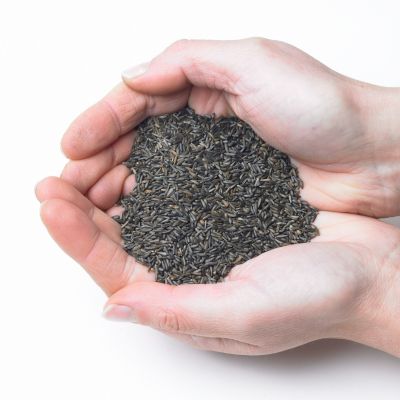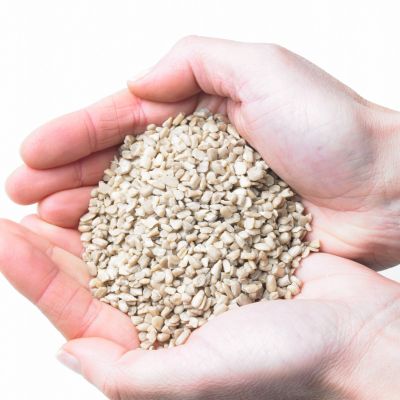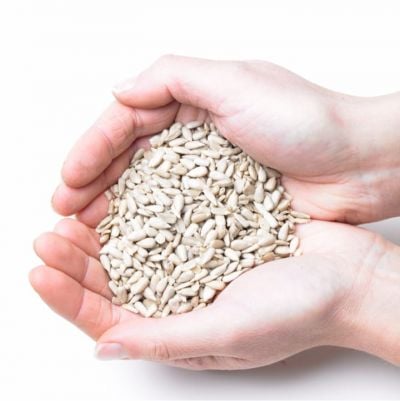Goldfinch Factfile
In its adult form, the Goldfinch is unmistakable with its red, white and black face, plus distinctive bright yellow wing stripe. This is a sociable bird, with small breeding colonies often formed, and outside of the breeding season nearly always seen in flocks and often with other species of finch. Along with its beautiful plumage, the Goldfinch has a delightful song. In gardens, the species is relatively easy to attract with niger seed and sunflower hearts. The Latin name for the Goldfinch is Carduelis carduelis.
The wingspan of the goldfinch is around 24cm and length of the bird is 12cm, which makes the species an average sized finch. Juvenile Goldfinches do not have the red face, though they’re still relatively easy to identify as they do have the yellow wing stripe, plus are always seen with adult birds of the same species.
The plumage of male and female goldfinches is almost identical, with this meaning that the sexes are hard to tell apart. The red on the face of the female goldfinch doesn’t extend quite so far behind the eye as on the male bird. There is a fair bit of variation in this so it isn’t a guaranteed way of telling male and female apart.
The Goldfinch’s song is distinctive and highly appealing. However, its bird song was also one of the reasons the species had previously declined, with widespread trapping taking place for the caged bird industry. Thankfully this practice has long been illegal, and indeed it was one of the RSPB’s earliest campaigns which led to this happening.
Video footage of Goldfinches
Goldfinch nesting and breeding habits
Goldfinches will often nest in small, loose colonies, with nests being built from grasses, moss, lichen, and other available materials such as wool and hair to bind the nest together. The nest is neat and well-constructed, and generally located relatively far from the ground in tight tree branches, a tall shrub, hedgerow or thicket. In gardens, evergreen conifers are also used. The female bird builds the nest, though the male may bring materials to her. Incubation of the eggs is solely carried out by the female, though both parents feed the young. There are two to three broods each season, with a clutch size of around five eggs.
Goldfinch history and population trends
The Goldfinch population has been steadily increasing over many decades (though there was a notable reduction between the mid-70s and mid-80s), with the species also extending its range more into northern Britain. This very long-term trend is probably partly due to the end of widespread persecution which the species suffered up until the 1930s, plus, and in more recent decades, its adoption of garden feeders as a major source of food. Indeed, the species has especially taken to bird food such as niger seed and sunflower hearts, with this also helping to improve winter survival rates.
Behaviour traits of Goldfinches
Goldfinches are social and gregarious birds both in and outside the breeding season, and are rarely seen alone on garden feeders, though frequently squabble between themselves for perch position. Perhaps their most interesting behaviour is the ability to hold onto plant stems and seed heads to remove tiny individual seeds, which they’re able to do with their exceptionally thin and pointed (for a finch) bill.
The species frequently move around to feed, with small flocks adopting a light and bouncing flight as they look for suitable seed heads – and of course garden bird feeding stations. They’re also fairly vocal as they fly, with a soft twittering call.
Goldfinch diet and food
In the autumn and winter months the Goldfinch’s natural diet is made up of seeds and in particular those of thistle, teasel, dandelion and other similar plants, plus seeds from alder and birch trees. In the spring and summer a wide variety of insects are also taken including aphids, caterpillars and small beetles. They also take invertebrates to feed their young birds in the nest and also their fledglings. In gardens, Goldfinches have, over the last few decades, increasingly taken to feeding on niger seed and sunflower hearts. Indeed they are now one of the most common bird species to be seen on bird feeders and bird tables.
The Goldfinch’s beak is unusually pointed for a finch, with this adaptation seemingly having evolved to extract tiny seeds such as teasel from the dead blower heads of the plant. And it’s this shape of beak which also allows goldfinches to remove niger seeds from the very small ports on special niger seed feeders – something most other species of finch are unable to do (siskin and redpoll being the exception).
What should I feed Goldfinches?
We recommend the following products to help attract Goldfinches to your garden.
Sunflower hearts
Niger seed
Premium Finch Mix
These foods will also attract other members of the Finch family.
Bird Food
Frequently Asked Questions
What attracts Goldfinches to the garden?
The best way to attract Goldfinches to your garden is by putting up a hanging tube feeder and filling it with sunflower hearts. Niger seed will also help attract Goldfinches, but note that you’ll need a special small seed feeder.
What time of day are Goldfinches most active?
Like virtually all songbirds, Goldfinches are most active first thing in the morning. This is especially true during the spring months when male birds are singing in order to attract a mate and define their territory, though during the winter months the priority at first light is to find food.
Where is the best place to put a Goldfinches feeder?
The best place for a Goldfinch feeder is in a relatively open area of a garden – so perhaps hanging from a branch of a solitary tree, or from a feeding station situated on a lawn.
What is the best bird seed for Goldfinches?
The best type of seed for Goldfinches is sunflower hearts and niger seed.
What is the best bird house for Goldfinches?
Goldfinches don't use bird houses or bird nest boxes, but instead build a nest at the end of tree branches, a bush or hedge.










